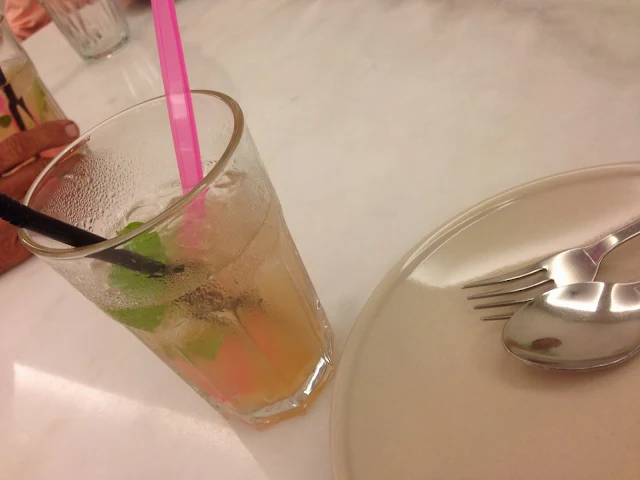 |
| A simple but appetising egg omelette as starters. |
 |
| Gulai Ikan Tumis or sour and spicy fish curry. |
The previous long standing branch of jewellers B.P De Silva, almost at the corner of Bishop and Beach streets in the old quarter of Georgetown, has a few months ago been transformed into a hub of Straits Chinese cuisine. Straddling two shop lots, located in an evening quiet location but near to the banking district on business days, Aunty Gaik Lian's provides a refreshing change to the Nyonya food landscape on Penang island. I have always found that the best Straits Chinese food is found in homes in Penang, like what my Mum dishes out, and it has been exasperating to be really satisfied with commercial outlets in this cuisine. The Penang variation of such Peranakan food tends to be more influenced by ingredients and cooking styles from Thailand and the Malayan peninsular , when compared to the Malacca version (with more of stronger Indonesian influences and the use of the buah keruak fruit).
With family in tow - and they had tried Gaik Lian's earlier through an introduction from one of my aunts in London - I already had expectations when we walked into the spacious surrounds of the cafe restaurant on a Sunday evening. I had phoned Adrian the son to book a table and he was most friendly making the table booking for me. There was a respite from the daily rain pour - vehicle parking was most easy on such an evening but it can be difficult otherwise on working days. The theme at Aunty Gaik Lian's was retro, practical and easy going. There were other tables filling up with more people that night. We wanted to sample what Aunty could offer.
There is an old Honda motor bike displayed at the shop window and the kitchen is discreetly hidden away on the right hand side. A gentle and underlying reminder of yesterday in Penang was balanced by the quality and freshness of ingredients used. Aunty Lian is perhaps one of the best students of a well known cookery and Straits Chinese cuisine teacher from yesteryear - Mr Beng Yam. So the nuances and attention to detail, so significant in what separates good from ordinary Nyonya cooking, did show up that evening. Penangites are careful and critical about their food. So the conversation inevitably went to compare the strengths and bite of Aunty Gaik Lain's Choon Pneih with those produced by her competitors at the CRC, Penang Swimming Club, the Littler Kitchen at Noordin Street and Mama's Nyonya Restaurant at Abu Sittee Lane.
 |
| The Choon Pnieh, or deep fried spring rolls influenced by Hainan cooking traditions, accompanied by the all important dipping sauce (right of photo) which includes British Worchestershire sauce. |
Aunty Gaik Lian came out herself, to chat with the clientele and asked us of we wanted more servings of steamed rice. As the meal progressed, we were delighted to discover that Lian's husband is a classmate of my eldest brother and he could recognise each of us int he family. It suddenly brought me back good memories of being with all my brothers at home, me still growing up with vague but sure recollections of friends of brothers dropping by to visit.
The menu is not extensive but sufficient, in my view. There are starters lined up and then several choices for the mains, with perhaps a limitation on curry options or dessert choices ,but servings are optimal and neither too little nor too much.
You can look out on the street which has nightclubs nearby and the place is close to where both backpackers and cruise ship passengers can wander by. People doing the walking heritage trail in the old precinct of Georgetown can choose to have a lunch here as well. In the end, I reckon having a meal at Aunty Gaik Lian's is akin to being at home, partaking in dishes lovingly cooked by a close relative.
Would I return? A definite yes. The dishes I had preference for had flavours, texture and a wholesomeness much to my taste. I particularly liked the Choon Pnieh and the signature egg omelette.
Adrian could recommend dishes and their serving size to suit our numbers. Nothing was over salty or under whelming on the palate. Gaik Lian had generously provided us a special touch with the dessert. Tables were not packed too close like in some smaller establishments. I would be confident to bring both locals and visitors here.
 |
| A cooling drink before dinner starts. |






































